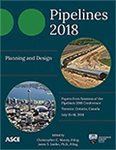Pipelines 2018
Using the Alternative Delivery CMAR Method to Reline Two 12-ft Diameter Steel Pumping Plant Discharge Pipes and Discharge Manifold Piping at the Central Arizona Project
Publication: Pipelines 2018: Planning and Design
ABSTRACT
The Central Arizona Project (CAP) recently completed relining two 12-ft diameter steel pipes and associated manifold systems at the Mark Wilmer Pumping Plant on Lake Havasu in western Arizona, using the construction manager at risk (CMAR) project delivery method. The Mark Wilmer Pumping Plant withdraws about 1.6 million acre-feet (ac-ft) of water each year from the Colorado River and via six pumps lifts the water through two 12-ft diameter steel pipes about 850 ft to the Buckskin Mountain Tunnel. The pumps are arranged in two-sets of three units which allows isolation of three pumps, a single manifold, and a single discharge pipe for maintenance while still operating the other three units and associated valves and piping. The two 144-in diameter steel discharge pipes are each about 2,300 ft long with slopes that vary from about 9° to 45°. The discharge pipes and manifolds were installed with the construction of the pumping plant in the early 1980s, and the pipes and manifolds lined with a hot-applied-cold-tar-enamel (HACTE) in 1982. In 1986, the plant was commissioned and has been moving water for over 30 years. In 2016, the right pipe and manifold was relined, and in 2017 the left pipe and manifold was relined. As part of CAP’s ongoing asset management program, the manifolds and discharge pipes have been inspected multiple times, and while it was apparent the HACTE was failing, CAP performed spot repairs of the lining as outages and internal man-power allowed. In 2012, it became evident the lining had reached its end and more than just spot repairs would be required to protect the integrity of the steel pipe. A project was developed to remove the HACTE and replace it with a modern coating system. Due to the physical extremes of the work and short outage window, it was decided to use an outside contractor to perform the work, and rather than use the traditional design-bid-build delivery method, CAP decided to use the CMAR approach. This paper will examine the initial development of the project surrounding the decision to use CMAR, outline the contractor selection process and the pros/cons surrounding that process, discuss the role the selected contractor played in the design (pre-construction services) of the new coatings system, then look at the development (negotiations) of the guaranteed maximum price (GMP), and finally review the delivery of the project. A brief discussion of CMAR versus design-bid-build and how the CAP approaches each will also be included.
Get full access to this article
View all available purchase options and get full access to this chapter.
REFERENCES
The Construction Management Association of America, August 2012, “CMAA Owner’s Guide to Project Delivery Methods”, cmaanet.org.
Design Build Institute of America, April 2015, “Choosing a Project Delivery Method”, dbia.org.
Information & Authors
Information
Published In
Pipelines 2018: Planning and Design
Pages: 237 - 244
Editors: Christopher C. Macey, AECOM and Jason S. Lueke, Ph.D., Associated Engineering
ISBN (Online): 978-0-7844-8164-6
Copyright
© 2018 American Society of Civil Engineers.
History
Published online: Jul 11, 2018
Published in print: Jul 12, 2018
Authors
Metrics & Citations
Metrics
Citations
Download citation
If you have the appropriate software installed, you can download article citation data to the citation manager of your choice. Simply select your manager software from the list below and click Download.
